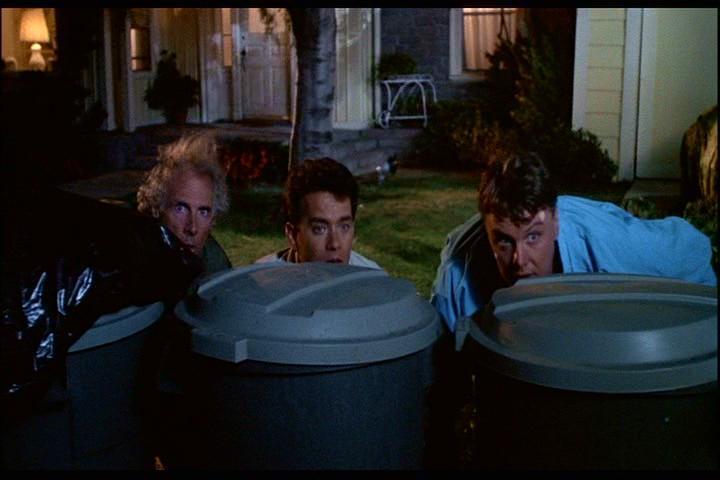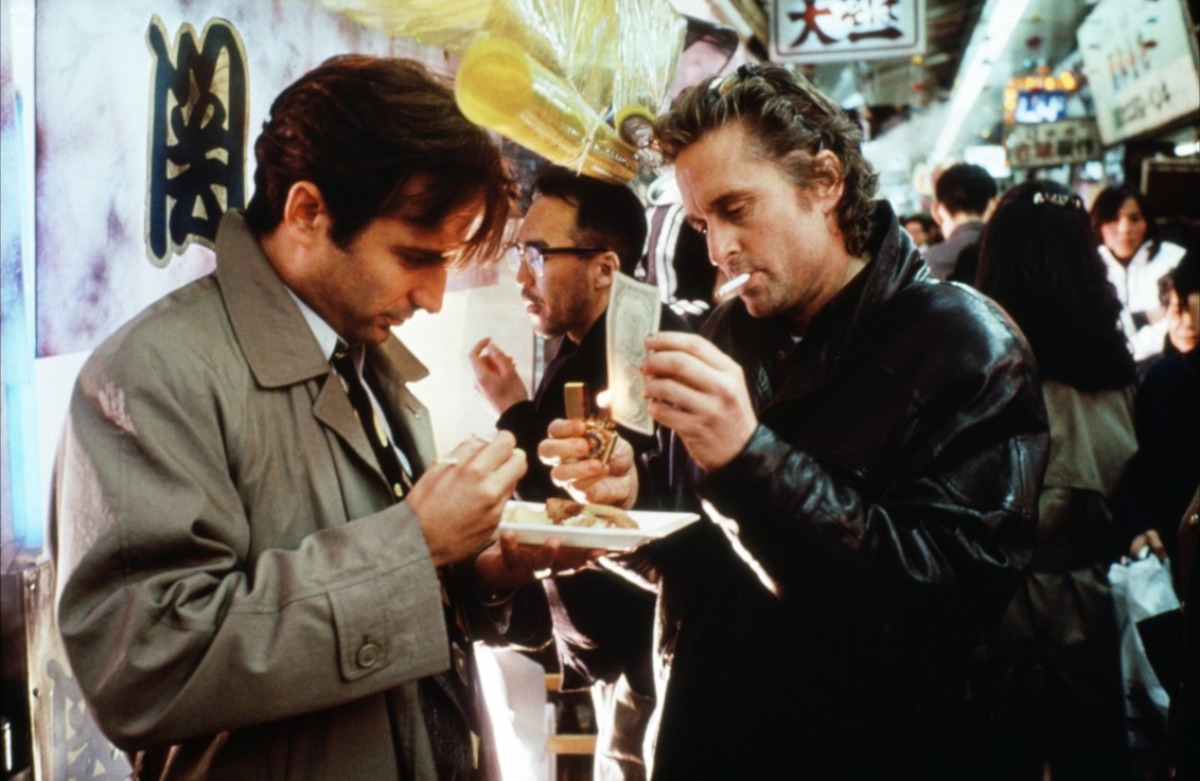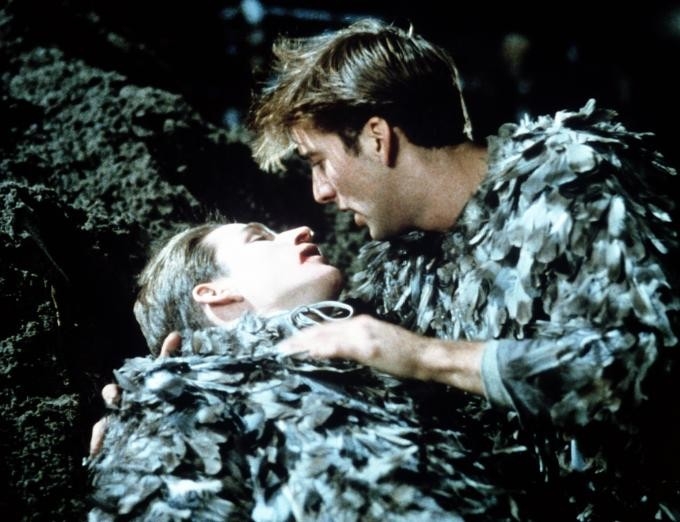20. Black Rain (1989)
Ridley Scott’s police thriller, Black Rain, came out at a time in which there was a new cop thriller being released pretty much every week in America movie theatres. They often followed a flawed but decent middle aged detective who has a very young and charismatic partner. When the said charismatic partner is murdered, the tired but moral detective takes it on himself to bring his partner’s murder to justice.
Very simply put, that’s the gist of Black Rain, with Michael Douglas as the middle aged detective and the compulsively likable Andy Garcia as the ill-fated but lovable partner. What the film also deals with, however, and what makes it unique is this: Douglas’ adventure takes him from America to Japan, and the story, while not forgetting its action or revenge thriller roots, actually turns into a very contemplative and moving film that explores cultural differences in everything from business to friendship to ethics.
Douglas portrays a great flawed hero that doesn’t fall into clichés, and Scott is right at home in the city landscape of downtown Japan, creating his most visually arresting film since Blade Runner. Every bit as entertaining and clichéd as it is thoughtful and sensitive, Black Rain is an overlooked eighties cop thriller that should be every bit as renowned as Lethal Weapon or Die Hard.
19. The Burbs (1989)

Director Joe Dante’s darkly comedic but overwhelmingly fun look at the dark side of suburbia should have been a more accessible, family-oriented companion piece to David Lynch’s masterpiece of suburban horror, Blue Velvet. Instead, it was pretty much just written off as another dumb Tom Hanks comedy (keep in mind, this was before he was “Tom Hanks: Great Actor”).
Hanks stars as a bored suburbanite on home vacation who starts suspecting his very strange new neighbors of some suspicious and potentially criminal activity going on next door. Hijinks, miscommunications, and quite horrific occurrences ensue, as Hanks slowly loses his mind to paranoia and obsession.
The true brilliance and point behind The Burbs is that it really doesn’t matter what Hanks’ freakish neighbors are truly up to. It’s that his character is so bored, unfulfilled, and dissatisfied with his life that he has no choice but to obsess over their every trivial move. While it appears to be a very dumb comedy on the surface, The Burbs ultimately reveals itself to be a very smart and misunderstood satire of eighties American suburban life.
18. Birdy (1984)
Matthew Modine and Nicolas Cage star in Alan Parker’s very strange, very beautiful coming of age story set around the time of the Vietnam War.
Modine and Cage are childhood friends, with Modine being the odd one of the pair who never had much interest in anything other than studying birds.
Both young men head off to Vietnam, years pass, and Cage becomes a wounded veteran while Modine is in a psych ward because the traumas of the war have lead him to believe he is now actually a bird. Cage is convinced to visit his old friend and try to bring him back to reality.
Modine and Cage deliver fantastic early performances, and the film’s sensitivity and bizarre nature make it stand out from other, more standard coming of age stories set around the same time. Highly unique, stylized, and graceful, Birdy is a stunning and heartfelt film that is truly one of a kind.
17. Lucas (1986)
Like Say Anything, Lucas is one of the rare teenage comedy/dramas from the eighties that actually treats is subjects like sensitive, thinking, feeling human beings. The story centers around an accelerated teenage prodigy (the title character) who is several years younger than most of the students in his high school class. As a result, he is teased mercilessly, bullied, and shunned from the social groups to which he wants to belong (while also ignoring the ones who want to accept him).
Played by Corey Haim, Lucas is a great character played with great intelligence by a very promising young actor. Lucas is contradictory, lonely, desperate to be loved, and alienated by his own gifts and intelligence. Haim easily delivers the best performance of his career in this film. It offers a very sad glimpse and a very painful reminder as to what might have been if the decade that had rewarded Haim so heavily for his gifts hadn’t also so completely and utterly eaten him alive.
16. The Mosquito Coast (1986)
In what is reportedly his personal favorite performance, Harrison Ford plays an eccentric, megalomaniac inventor who uproots his family to Central America to build his own society. When he successfully builds an ice factory, it appears that his mission is a success. However, when religion, nature, and personal ego collide, all the best intentions unravel and Ford’s master plan soon becomes a nightmare.
Directed by Peter Weir and adapted by Paul Schrader from Paul Theroux’s novel, The Mosquito Coast was a commercial and financial failure upon its release.
The lack of a black and white villain or hero certainly played a hand, as did the usually charismatic Ford’s sometime maniacal and unlikable performance. Given another look, however, the film is actually a beautiful cautionary tale about the arrogance of forcing technological advancements into areas of the world that simply aren’t ready for them.
15. The Hunger (1983)
David Bowie and Catherine Deneuve star as centuries-old and very stylish New York eighties vampires looking for a cure to their inevitable aging. A very young Susan Sarandon plays a scientist who just might be able to help them.
Tony Scott’s hyper-stylized directorial debut is a fascinating look at what the late director’s career could have been.
Filled with abstract edits, smoke-fuelled modern noir photography, and an industrial soundtrack that unnerves its audience, The Hunger owes a great deal to abstractionist horror maestros like Polanksi or Nicolas Roeg. Notably, it also owes a great deal less to the slick, commercial-style storytelling Scott later made his fortune and name from in the form of films like Top Gun or Beverly Hills Cop 2.
The Hunger is the type of work the director never fully revisited, perhaps because it’s initial failure disheartened him early on from pursuing riskier, more artistically inclined work. While Scott found his voice again later in his career with films like True Romance, Man On Fire, and Revenge, it still does make you wonder just how original and daring Scott’s career might been earlier on had this more experimental project paid off for him so early in his career.
14. Lady In White (1988)
One of the creepiest, most underrated, and under-known horror/suspense films of the eighties, Lady In White works on a variety of levels. It is a very involving murder mystery, a very tragic family drama, and a really terrifying ghost story that gets under your skin and stays there.
Lukas Haas (post-Witness fame) plays a small boy locked in a school closet over night as the result of a cruel prank. During the course of the night he witnesses the ghost of a young girl re-enact her brutal murder before his very eyes. The girl’s killer soon begins stalking Haas, and the young boy has to solve the murder in order to save himself and put the girl’s spirit (and the spirit of her wandering, grieving mother) at rest.
Lady In White was buried amongst many of the more high profile horror thrillers that were released during the same time period. Its disturbing effectiveness and undeniable quality, however, should have made it rank right amongst the best horror films of its time, including such eighties horror masterpieces as The Shining or The Thing.
13. (tie) Cruising and To Live and Die In L.A. (1980 and 1985)
The eighties just would not have been the eighties without the madman filmmaker we all know (and many of us love) as William Friedkin. Films littered with insane car chases, synthesized scores, cheesy one-liners about aging, and hard-edged, morally ambiguous police officers that are just as corrupt as the criminals they pursue… These trending styles and themes didn’t necessarily start with William Friedkin, but Lethal Weapon, Die Hard, and every subsequent action movie to be released in the next few years certainly wouldn’t have been quite the same without the irreplaceable (and sadly forgotten) Friedkin influence.
Friedkin got his due in the seventies with the Oscar-winning success of The French Connection and the blockbuster horror sensation of The Exorcist, but soon lost his clout when more challenging projects such as Sorcerer failed to take hold with audiences and critics alike.
Cruising, in particular, brought a great deal of controversy to the director’s career. Starring Al Pacino as an undercover police officer investigating a string of grisly murders in the underground homosexual night club scene, Cruising was unable to shake it’s initial criticisms of homophobia and gay-bashing.
While thoroughly researched for its time and more interested in exposing the hatred it was accused of glorifying, Crusing’s misunderstood nature caused further damage to Friedkin’s already fragile career. In Cruising, Friedkin pushed boundaries in both style and in presenting taboo themes of the time. Unfortunately, he was grossly underappreciated and savagely misunderstood for both.
To Live and Die In LA, on the other hand, is an excessive, brilliant, and unapologetic glorification of eighties schlock action filmmaking…. And the result is utterly genius, thrilling, and every bit as much a mark on its times as The French Connection had been over a decade earlier.
A perfectly grizzled William L. Peterson stars as a DEA agent who will stop at nothing to bring down the counterfeiter (a bizarre, artsy villain played by Willem Dafoe) who murdered his partner. The plot is typical (especially for the time), but it’s the utter gusto, saturation, explosiveness, and unapologetic display of machismo in which the film is presented that makes it the pop masterpiece it actually is and never got the credit for being.
At the end of his recently released biography, The Friedkin Connection, Friedkin laments that he most likely will never get the chance to make his true masterpiece, his Citizen Kane. What he forgot or perhaps missed in this statement is that, in his own way, his own style, and in his own voice, he truly already has many times over.
12. Trouble In Mind (1985)
Robert Altman protégé Alan Rudolph had a fascinating, quirky career as a writer-director in the eighties that slightly carried over into the nineties. His films always left an impression, but were never quite strange or sensationalistic enough to cause much of a stir outside of the critical community.
At the height of his artistic prime with films like Choose Me, The Moderns, and, of course, Trouble In Mind, Rudolph was never able to entirely fit in with any movement or style. Perhaps classifiable somewhere between Jim Jaramusch and David Lynch, Rudolph still never quite found his much-needed niche to help him gain a more widespread audience.
One such obscure casualty in his fascinating career is Trouble In Mind, a modern noir set in the fictional Rain City about an ex-con (a perfectly cast Kris Kristofferson) trying to help a troubled young mother start her life over without her loser criminal boyfriend (Keith Carradine) always getting in the way. The story, while interesting and thrilling, isn’t really the point, however.
It’s the mood, it’s the atmosphere, it’s the looks between the actors, it’s Mark Isham’s jazzy score, and it’s just the world of Trouble in Mind in general that keeps you entranced from beginning to end. There’s nothing quite like it, and there’s no way of understanding it other than to experience it for yourself. As an added bonus, you also get to see John Waters’ regular, the late Divine, in his only non-drag cinematic role.
11. Inside Moves (1980)
Hollywood blockbuster director Richard Donner, the man who gave us Superman, The Goonies, Lethal Weapon, Scrooged, and countless other Hollywood classics, once upon a time made a very small, personal, and character-driven film which he once considered to be the most important film of his career (and perhaps still does). The only problem was, nobody saw it.
At a time before independent film was really even a thing, Donner independently financed and released this passion project about friendship, depression, and finding your purpose in life in the most unlikeliest of places. While it contains plenty of the director’s trademark optimism, Inside Moves also presents a very real look into the lives of struggling social misfits hurting to find their places in the world.
Featuring great early performances from John Savage and David Morse, Inside Moves is a touching and beautiful film from a director who never quite ceases to surprise us.








